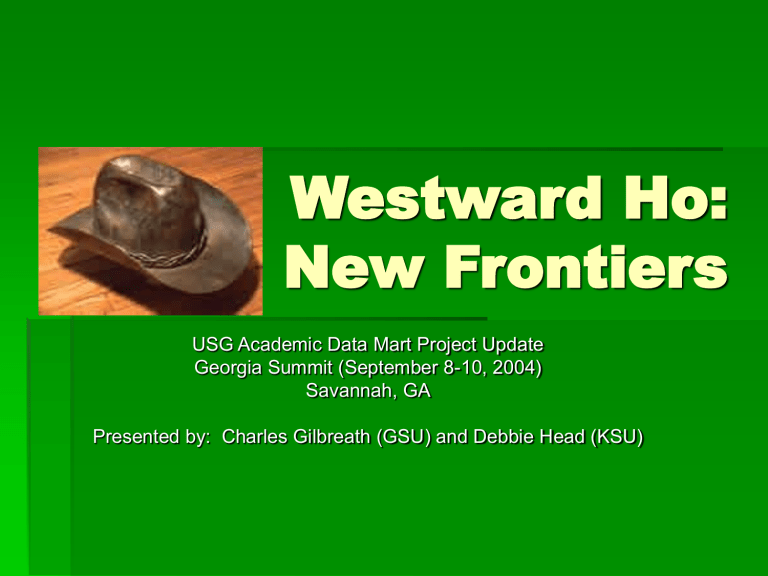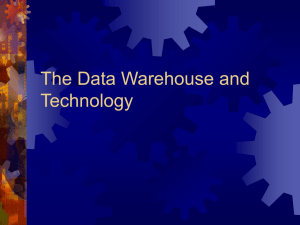Westward Ho: New Frontiers

Westward Ho:
New Frontiers
USG Academic Data Mart Project Update
Georgia Summit (September 8-10, 2004)
Savannah, GA
Presented by: Charles Gilbreath (GSU) and Debbie Head (KSU)
What A Data Warehouse Is
Not!
Transactional systems are designed to respond rapidly to individual events such as registering for a course, paying fees, etc.
Transactional structure is highly normalized
(broken into many small pieces)
Transactional systems are not designed for queries
What a Data Warehouse
Is!
A data warehouse is a set of tables that are designed to respond quickly to queries.
They are denormalized (data may be repeated within a table)
They are designed to store history.
They are designed to bring pieces together from different transactional systems, such as
Student Information, Human Resources,
Facilities, etc.
They may contain multiple “data marts” that store related data
USG Academic Data Mart
(ADM) Defined
The USG Academic data mart is designed to incorporate the institutional data from the legacy systems of SIRS,
CIR, FARS, RUR, Graduate Salary
Survey, High School Feedback, and
Learning Support/Core Curriculum.
The data collected in the Academic Data
Mart can be used by institutions for both local and official reporting needs.
ADM in simple terms….
Final objective of Enterprise-wide data warehouse will be a hybrid of old reporting systems (SIRS, CIR ,etc) with new data structures that will consider institutional needs
Transactional systems (Banner) will feed the data directly to the warehouse.
Data elements are arranged in tables in a database managed by OIIT. Data structures reflect institutional needs.
ADM expectations
The data fields were selected initially based on the data fed to SIRS and CIR.
It will expand beyond those elements when it proves its functionality
Still working on how to load longitudinal data
Canned reports, SER for example, will be available
Sharing of reports generated by others in our group so you won’t have to “recreate the wheel” each time.
Why Does IRP Care about the ADM?
For institutions with limited resources, people and equipment, they can access their own data to do internal analyses as desired.
Brings the USG more in line with the current technology in terms of housing and using data
Takes the “data jail” concept and lets us actually get some data out
Hopefully brings some consistency and understanding about what goes into reporting
Reporting should become easier.
Data warehouse tables should match production tables
Data Warehouse Structure
ERD – Entity Relationship Diagrams show the main table (FACT table) and how other tables
(Dimensions) connect to the main table. It is a detailed scheme of the many elements within each component
Find these at this link: http://www.usg.edu/usgweb/sitcap/usg123_aca/index.phtml?id=pmd/pmd_br
What data are accessible?
There are 5 different data components of the ADM organized into “data marts” that are collections of associated data:
Class Session – (Class schedule/catalog)
Student Profile – (Demographics)
Course Enrollment – (Registrations)
Student Term Enrollment – (Student
Record)
Student Test Results – (Test scores)
Class Session
Class Session data are extracted from
Banner
Includes “course catalog” data such as
Course number, section, times and days offered, credit hour value of the course
Does not include credit hours generated or number of students enrolled
Student Profile
This data mart will provide much of SIRS data.
Includes many of the SIRS data fields
You can access and report and clean the data prior to releasing it to OIIT.
Editing reports should let us “scrub” it better before it goes into the “official” warehouse
Student Course
Enrollment
Will load some of CIR enrollment data
Will be the source for Credit Hour
Production Reports by the USG.
Will link to the Class Session Component so that individual student enrollment information can be accessed
Student Term Enrollment
Contains data on each student enrolled in one or more courses in an academic term
Contains cumulative data for each student
Is linked to demographic, geographic, etc. data for each student.
Student Test Results
Contains information on detail level of test results as recorded in Banner
Allows selection on individual test types (ACT,
SATV, SATM, etc.)
Allows selection by student characteristics
(ethnicity, sex, etc.)
Getting Data Back Out
Business Objects – pre-selected sets of data
What makes sense in terms of types of information we (IRP) need to know?
For example: A predefined First-time Fulltime Freshmen grouping so average SAT, gpas, ages, ethnicity, gender, CPC, LSP could be gathered just about that group?
What else?
Process for Meeting IRP’s needs
Identify data needs and generate list of desired reports
Timetable for us and OIIT
What is review process for requests of reports? (Does IRP recommend a standing data warehouse committee?)
Standing Data Warehouse
Committee
Identify data needs and pass on to report developers
(Some developers may be OIIT and some may be IRP members)
Facilitate sharing reports
Develop a process for recommending changes to data warehouse structure
Members reflect data warehouse user community
Finding Information About
What is in the ADM!
http://www.usg.edu/usgweb/sitcap/
ERD Web site
Using Discoverer
Reporting tool provided by OIIT
Administered at system level
Allows us to see our own institutional data
Can build our own ad hoc reports
If a report that would be beneficial to all, submit it to committee for review and approval to be put in the master list of available reports
Round the campfire
Questions, comments, suggestions
Meet the trail bosses of the ADM:
Lori Jarrard
Glenn Fernandez



